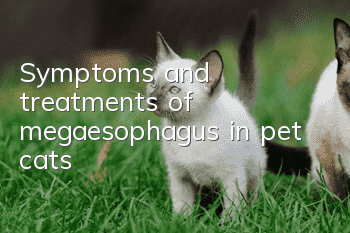Symptoms and treatments of megaesophagus in pet cats

Causes of megaesophagus in cats
Whether it is congenital or acquired, cats may suffer from megaesophagus. This disease is caused by abnormal basic movement ability of the esophagus. Cats of any age can develop the disease, and it often causes secondary pneumonia.
1. The cause of many cases is unclear, leading to the congenital category.
2. Many pathological conditions can cause or be related to esophageal dilation.
3. Acquired (secondary) causes include viral encephalitis, lead poisoning, myasthenia gravis, immune polyneuritis, systemic lupus erythematosus, polymyositis, thyroid degeneration, and adrenocortical gland degeneration , myotonia, trauma, tick paralysis, viral neuropathy, and other causes.
What are the symptoms of cat megaesophagus
Generally speaking, it is difficult for us to determine the cause of congenital megaesophagus, but for acquired megaesophagus, the cause can be identified more accurately. Megaesophagus refers to the dilation of the esophagus, weak esophageal motility, and inability to deliver food to the stomach well, which may sometimes be accompanied by vomiting.
Symptoms:
General: 1. Dehydration 2. Fever, fever, hyperthermia 3. Stagnation, retardation, developmental disorder in growth or weight gain 4. Underweight, weight loss, emaciation, poor posture 5. Weight loss
p>Digestive system: 1. Difficulty swallowing, dysphagia 2. Difficulty breathing, difficulty breathing through the mouth, grunting, gasping 3. Pharyngeal erythema, redness 4. Excessive salivation, excessive salivation at the mouth, sialorrhea 5 .Nausea, nausea 6. Occasionally vomiting or regurgitation, vomiting
Respiratory system: 1. Abnormal breath odor, foul smell in the mouth 2. Abnormal breathing sounds in the upper respiratory tract, obstruction of airflow, loud snoring, and rumbling sounds 3. Abnormal sounds in the lungs or pleura, rales, crackling sounds, wheezing, Rubbing sound 4. Cough 5. Increased respiratory rate, wheezing, tachypnea, hyperpnea 6. Mucous nasal discharge, serous, watery 7. Nasal pus-like discharge 8. Sneezing, sneezing
Skin system: Slow response to percussion in sunken or sunken areas
Nervous system: 1. Anorexia, loss or decrease of appetite, no food intake, stop eating 2. General weakness, paresis, paralysis 3. Bulimia, excessive appetite 4. Quadriparesis, weakness, paralysis
Treatment of cat megaesophagus
Cats with megaesophagus often have difficulty eating because the basic movement ability of the esophagus is weakened, resulting inFood cannot be delivered to the stomach properly, causing repeated swallowing or even vomiting. It can be said that this disease has a serious impact on cats’ daily diet, and the cause needs to be found out and treated as soon as possible.
1. Animals suffering from acquired megaesophagus can be treated at any time against the factors that cause esophageal dilation, and most of them will improve organ function.
2. Congenital megaesophagus and acquired megaesophagus that are ineffective in drug treatment can be treated symptomatically.
1. Elevating the position of the feeding trough facilitates the passage of food into the stomach.
2. Usually feeding a small amount is sufficient to meet physical needs.
3. Change the hardness of the food (compared with liquid juice and large pellets) to see which diet is best tolerated. Generally, solid pellets will better stimulate esophageal peristalsis and contraction.
4. Animals suffering from severe aspiration pneumonia require special attention.
3. Feeding through an ostomy tube after gastrography can ensure nutritional supply and reduce the risk of aspiration.
4. Broad-spectrum antibiotics can be used to treat bacterial infections.
- A cat will die if it urinates for a few days
- Should you deworm yourself or go to a pet store?
- Are cat teasers harmful to cats?
- What should I do if my cat suffers from chronic gingivitis?
- Cat's nails are cracked with a thin layer
- Cats go crazy after eating mutton
- What does cat moss on a cat’s chin look like?
- Can cats reproduce after abdominal transmission is cured?
- What exactly is the sterilization shot for female cats?
- Can I still eat unopened cat food if it has expired?



